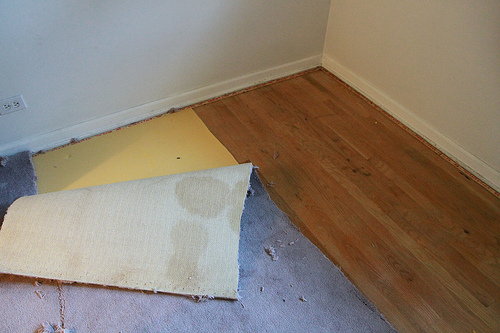Carpet Removal Tips

Photo of carpet removal by akeg/Flickr.
Carpet removal is the first step in updating the look of a room with outdated, stained, or damaged carpeting. If you’re installing your own new flooring, you’ll have to tackle this task on your own, and if you’re having a professional handle the floors, you might save money by removing the existing carpet and preparing the space. Ask for a quote to find out how much you’ll save by doing so to determine if it’s worth it to you; and remember, carpeting firms also haul the old carpet and underlayment to the dump or a recycling facility, which is something you’ll have to do if you handle the removal yourself.
Complexity of carpet removal depends on the room; it may help to have a family member assist, or to hire a handyperson to help get the project done more quickly. You’re going to need to start by totally emptying the room, which can provide a good opportunity for sorting and organizing. If you’re remodeling, get painting done before taking the carpet out, so you won’t have to worry about drips on the underlying floor or the new flooring once it’s installed.
Once the room is empty, take out any doors and shutters that open inwards, because they’re going to get in your way. Stack them out of the way and get your tools ready. Heavy gloves are required because carpeting is installed with an extremely sharp tack strip or carpet tacks, and a respirator is recommended to protect your lungs from dust and debris. You’ll need a pry bar and a pair of pliers along with a floor scraper.
Starting in one corner (if you’re doing stairs, start at the top of the staircase), pull the edge of the carpet up with your pliers to start separating it from the floor. If it’s held down with a tack strip, this process should go fairly easily. If, like older carpets, it was installed using tacks, you’ll need to use a prybar to remove the tacks. Tackstrips can be left in place if you’re planning on reinstalling carpet, unless they look worn, in which case you can pull them up too.
As you go, you can either roll the carpet up into one big roll, or cut it into chunks (tip: cut from the back, it’s a lot easier) and roll them up. Smaller rolls are easier to manage, which can be a distinct advantage if you’re hauling the carpet to the dump yourself.
Your carpeting may have some transitions between rooms. Leave some clearance around the transitions if a professional team is managing the installation because they can decide how to handle them and whether components like transition strips are salvageable.
Once the room is initially cleared, you may notice that parts of the underlayment have adhered to the floor and need to be removed with a scraper. The scraper can also be used to remove tacks and staples. If you’re not concerned about the condition of the subfloor, you can handle these problems fairly quickly. However, if you’re trying to restore original hardwood, you’ll need to be careful; work slowly and at a low angle to remove offending objects stuck to the floor without gouging it.
After you’ve removed carpet, you can sweep the room so it will be ready for the next step. If you’re working with a company that installs flooring they should be able to start work immediately, assuming you made arrangements ahead of time to give them time to schedule personnel and order materials. If you’re handling your own flooring installation or restoration, make sure to have supplies ready to hand before you start so you can minimize the disruption associated with your work.
Looking for a Pro? Call us (866) 441-6648

Flooring Average Costs
Flooring Contractors Experiences

Hardwood Floor Repair Done Perfectly AND Painlessly

Bathroom Flooring Replacement And A Mystery Solved



